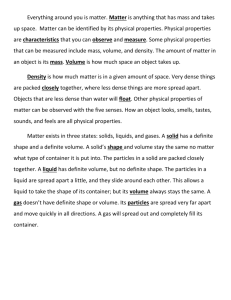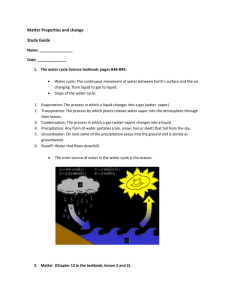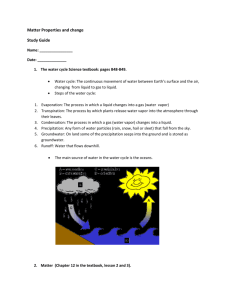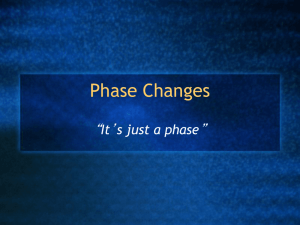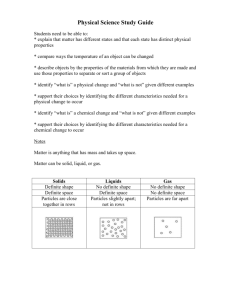PROPERTIES_OF_MATTER
advertisement
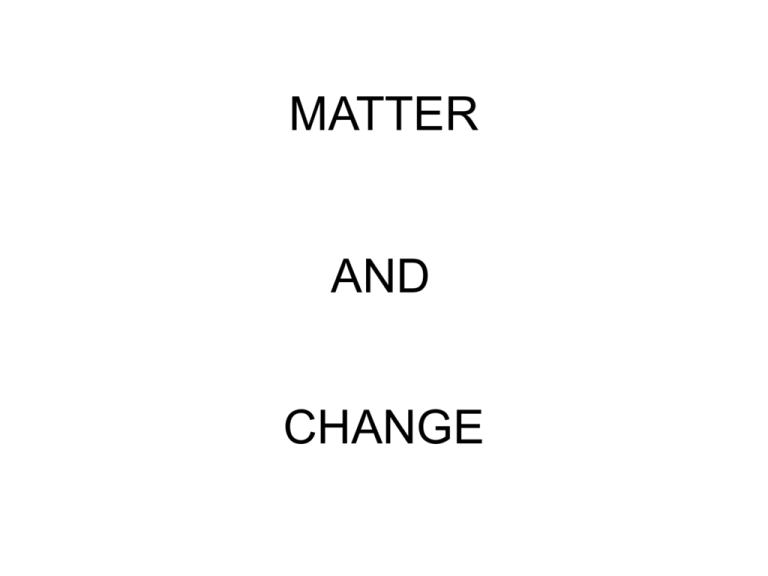
MATTER AND CHANGE Chemistry: The study of matter and the changes it undergoes. Matter Anything that has mass and takes up space Alchemical view of matter Matter • Atoms are the building blocks of matter Matter “Space-filling” models of molecules Matter Oxygen Hydrogen Each element is made of the same kind of atom Each element is made of the same kind of atom with unique set of properties Carbon Uncut diamond Graphite Uncut diamond with impurities STATES OF MATTER: Solid, Liquid, Gas (a) Particles in solid (b) Particles in liquid (c) Particles in gas STATES OF MATTER • SOLIDS – Definite shape and volume – Particles of a solid packed tightly together – NOT easily compressed SOLIDS STATES OF MATTER • LIQUIDS – Particles in close contact but arrangement is not orderly or fixed – Definite volume – NOT easily compressed In a liquid • molecules are in constant motion Liquid • there are appreciable intermolecular forces • molecules are close together • Liquids are almost incompressible • Liquids do not fill the container H2O(l) Water Zumdahl, Zumdahl, DeCoste, World of Chemistry 2002, page 31 STATES OF MATTER • GAS – Particles NOT in close contact and are constantly moving – No definite volume Some Properties of Solids, Liquids, and Gases Property Solid Liquid Gas Shape Has definite shape Takes the shape of the container Takes the shape of its container Volume Has a definite volume Has a definite volume Fills the volume of the container Arrangement of Particles Fixed, very close Random, close Random, far apart Interactions between particles Very strong Strong Essentially none How to describe matter… • Extensive properties – Depends on the AMOUNT of matter in a sample • Mass • Volume • Intensive properties – Depends on the TYPE of matter in a sample • Color • Temperature • Density SUBSTANCE • Matter that has a uniform and definite composition • Every sample of a given substance has identical intensive properties because every sample has the same composition • Elements CANNOT be broken down into simpler components • Compounds CAN be broken down into elements Examples of pure substances GOLD ALUMINUM Compounds • Made of two or more different kinds of elements chemically combined in a fixed proportion. – for example: • Common table salt is a one to one combination of sodium atoms (Na) and chlorine atoms (Cl) = NaCl What do we mean by “chemically combined”? • Elements in compounds are joined by chemical bonds. – Examples of chemical bonds: • Ionic bond (electrostatic attraction that binds oppositely charged ions) – Usually composed of metal and nonmetal atoms • Covalent bond (bond that forms by the sharing of electrons between atoms) – Usually composed of carbon atoms bonded to elements such as hydrogen, oxygen, nitrogen and sulfur Properties of Compounds • Compounds can be broken down into simpler substances by chemical means but elements cannot. • Compounds and the elements from which they are formed have different properties Examples of Compounds • Sugar (sucrose) – Composed of carbon, hydrogen and oxygen • Sugar a sweet-tasting white solid but carbon is a black, tasteless solid; Hydrogen and oxygen are odorless gasses Sugar Carbon + Water http://www.youtube.com/watch?v=A_jtOpAYG70 Sugar (sucrose) Sugar (sucrose) Properties of Matter • Physical properties: – Can be observed without changing a substance into another substance • Boiling point, density, mass, volume, magnetic Properties of Matter • Physical changes – Changes in matter that do NOT change the composition of a substance • Changes of state (liquid to a gas), temperature (melting point), volume, crush, grind • Chemical changes – Changes that result in a new substance • Combustion, oxidation, decomposition Mixtures • Physical blend of two or more components • Heterogeneous = composition is variable throughout the sample • Homogeneous = composition is uniform throughout the sample Classification of Matter

